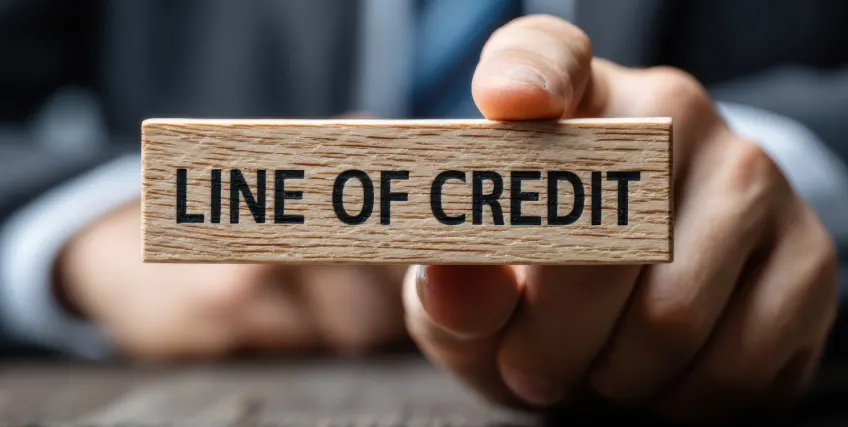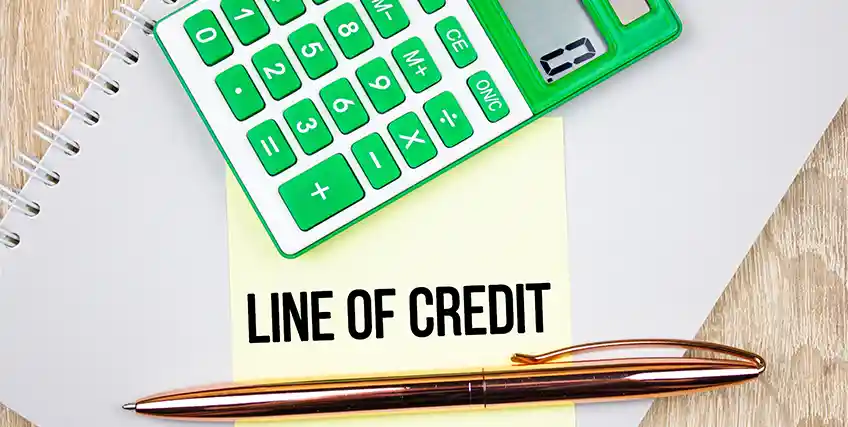How to Get a Business Line of Credit: A Comprehensive Guide
January 10, 2025 | Last Updated on: January 10, 2025

If you’re in need of financing for your small business, but you’re not sure how much funding you need and don’t want to pay interest on money you don’t use, a business line of credit might be right for you.
A business line of credit is a flexible financing option similar to a credit card. If you qualify, you’ll be approved for a maximum limit, then you can draw on that amount when you need cash, but you only pay interest on the amount that you use.
Here’s what you need to know about how to get a business line of credit for your business needs.
How To Get a Business Line of Credit
Business lines of credit usually have two phases: a draw period and a repayment period.
During the draw period you can borrow funds up to a preset limit, with interest accruing on borrowed amounts. Those funds are deposited directly into a business bank account. Monthly payments can start during the draw period or afterward, following a structured schedule until the borrowed sum is repaid in full. Interest rates on these credit lines are often variable, meaning they can change over time.
So for example, if you have a $10,000 business line of credit, but you only use $2,000 of it, you’ll only pay interest on that $2,000. If you need more cash for your business, you can always draw on the remaining $8,000. And as you repay that $2,000, the amount that is available for you to draw on goes back up accordingly.
They can also come as a secured business line of credit or unsecured business line of credit. It can be secured by a personal guarantee or collateral.
The Steps of How To Get A Business Line of Credit
If you think a business line of credit is right for your needs, follow these steps to get started.
Assess Your Business Needs
Before you start the application process, take some time to assess your business’s financial needs. Determine what credit limit you require and what you’ll be using it for.
While you may need the money for covering day-to-day expenses, purchasing equipment, or funding a specific project, having a clear understanding of your financial goals will help guide your application.
Check Your Credit Score
Your personal and business credit scores play a significant role in the approval process for a business line of credit. Lenders will analyze your credit history to assess your creditworthiness and risk level.
While building your credit profile, aim for a 680 credit score or above to increase your chances of approval. If your credit score is less than stellar, work on improving it before applying for a line of credit.
Gather Your Financial Documents
Lenders will want to see a variety of financial documents to evaluate your business’s financial health.
These may include tax returns, bank statements, profit and loss statements, balance sheets, and cash flow projections. Be prepared to provide these documents to support your application.
Submit Your Application
Be thorough and accurate when completing the application form, and don’t leave any blanks unanswered. Most digital applications will flag these errors for you to ensure your application has a faster processing time.
Wait for Approval
After you’ve submitted your application, the lender will determine your eligibility. The approval process can vary from a few days to a few weeks depending on the lender and the complexity of your application. Online lenders may be able to approve you quicker than a credit union or traditional bank.
Be patient and responsive to any requests for additional information or documentation.
Review the Terms
Once your credit approval comes through, carefully review the disclosures of the loan agreement before signing on the dotted line.
Pay close attention to interest rates, fees, repayment terms, and any other important details. Make sure you fully understand your obligations as a borrower.
Once you fully agree to the terms, you will get access to the line of credit, and you can begin withdrawing funds into your business checking account.
Small Business Line of Credit Fees
While a business line of credit can provide valuable financial flexibility, it’s essential to understand the associated costs and other requirements involved. Like any decision, be sure to compare pricing between several lenders to find the best deal. Here are some common fees you may run into:
Interest
Like any form of borrowing, you’ll typically pay interest on the funds you use from your line of credit. Interest rates can vary depending on factors such as your creditworthiness, the lender’s policies, and market rates.
Origination fee
Depending on the lender you use, you may have to pay an origination fee for the business line of credit. Origination fees usually range from about 0.5% to 5% of your total loan amount, but can vary depending on the lender.
Draw Fees
Some lenders may charge a fee each time you draw funds from your line of credit. This fee is usually calculated as a percentage of the amount drawn.
Processing Fees
There may be upfront processing fees associated with opening a business line of credit. These fees cover the cost of underwriting and approving your application.
Late Fees
If you fail to make timely payments on your line of credit, you may incur late fees or penalties. Late fees can add up quickly and negatively impact your credit score.
Annual Fees
Some lenders (both online and traditional lenders) may charge an annual fee for maintaining access to your business line of credit, regardless of whether you use the funds.
Early Repayment Fee
This is a penalty for repaying the loan ahead of schedule. Lenders may impose this fee to compensate for the interest income they would have earned if you had continued to make payments over the original term. It’s important to be aware of this fee when considering early repayment, as it can impact the overall cost-effectiveness of using the line of credit.
Drawbacks to Lines of Credit
A business line of credit can be a valuable financial tool, but like any financial product, it comes with potential pitfalls. Here are some common ones to be aware of:
- Overborrowing: It’s tempting to max out a line of credit, especially when it’s readily available. However, borrowing more than your business needs can lead to financial strain down the line, as you’ll have to repay the borrowed funds along with interest.
- Dependency: Relying too heavily on a line of credit as a loan option to cover ongoing expenses can indicate underlying financial issues within your business. Using it as a band-aid solution rather than addressing root problems could lead to a cycle of debt.
- Credit Score Impact: Just like with personal credit cards, using a business line of credit affects your business credit score. Late payments or high credit utilization can damage your personal credit score and/or business credit score, making it harder to secure favorable terms on future financing.
- Unexpected Fees: Read the fine print carefully. Some lines of credit come with fees for things like maintenance, drawdowns, or prepayment penalties. These fees can eat into your available funds and increase the overall cost of borrowing.
- Renewal Risk: Lines of credit are typically renewable annually or semi-annually. Your lender reserves the right to not renew your line of credit based on changes in your business’s financial health or market conditions. Losing access to a line of credit can be problematic if your business relies on it for liquidity.
- Term Mismatch: If you’re using a line of credit to fund long-term investments, there may be a mismatch between the short-term nature of the line of credit and the long-term payback period of your investments. This can lead to cash flow problems when it’s time to repay the borrowed funds.
Alternatives to a Business Line of Credit
While a business line of credit can be a valuable financing tool for small business owners, it’s not the only option available. Before you decide on a financing product, shop around different lenders to see what products, terms, and rates they offer. Doing so will ensure that you find the best product for your needs, which can have a lasting impact on your business in the near and long term.
Here are some alternatives that small business owners can consider:
Small Business Loans
If you need a lump sum of capital for a specific purpose, a small business loan may be a better fit. These loans typically have fixed repayment terms and may offer lower interest rates than a line of credit. A term loan for small business could be a better fit for a purchase like real estate or equipment.
Business Credit Cards
For smaller expenses or short term financing needs, a business credit card can provide convenient access to funds. Look for cards with rewards programs and low introductory APRs to maximize benefits.
The key difference between a business credit card and a small business line of credit is that the business credit card is likely to have higher interest rates and makes it harder to withdraw cash, but at the same time you won’t pay interest on the credit you use unless you are late making a payment.
Merchant Cash Advances
For businesses with consistent credit card sales, a merchant cash advance, or revenue based financing, offers a lump sum of cash in exchange for a percentage of future credit card sales or annual revenue. It provides fast and convenient funding for business owners who need it.
It’s not a loan, so there is no fixed term or interest rate. Payments are flexible based on business performance, and can be used as working capital. However, it can come with higher interest rates and fees than other types of funding.
Final Thoughts on How To Get A Business Line of Credit
As a new business, startup, or established business, a business line of credit could come in handy if you may have upcoming costs you need to finance. Be sure to consider other credit products and credit options to find the most competitive rate and best credit offer for your financial needs.
FAQs about How To Get A Business Line of Credit
Can an LLC open a business line of credit?
Yes, an LLC can open a business line of credit. The LLC holder needs to meet the lender’s qualifications, such as having a solid credit history and sufficient revenue.
How do I get a business line of credit?
To get a business line of credit, you’ll need to apply through a bank or lender by demonstrating strong business financing fundamentals like consistent revenue and a good credit score.
What is the minimum credit score for a business line of credit?
The minimum credit score for a business line of credit typically ranges from 600 to 680, depending on the lender’s requirements and which credit bureau they may use.
How long do you have to be in business to get a business line of credit?
Most lenders require a business to be operational for at least six months to a year to qualify for a line of credit. However, some lenders may offer options for newer businesses with strong financials or collateral.




